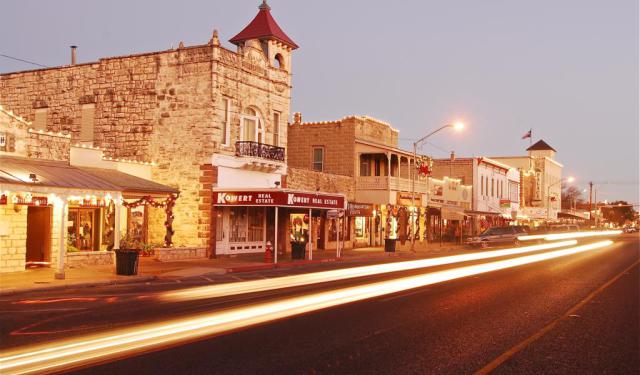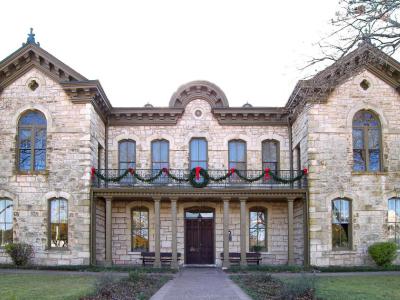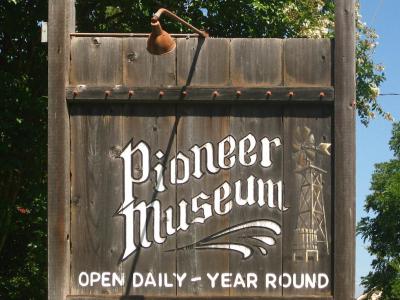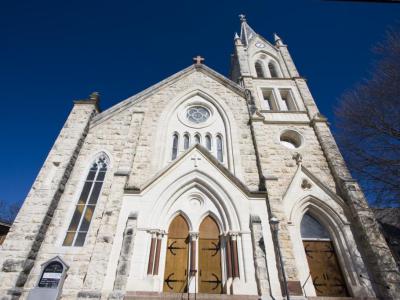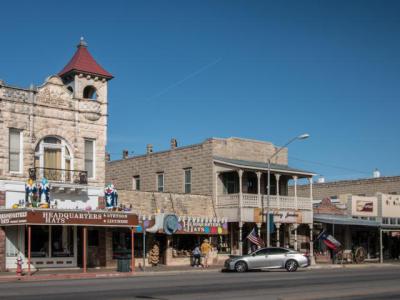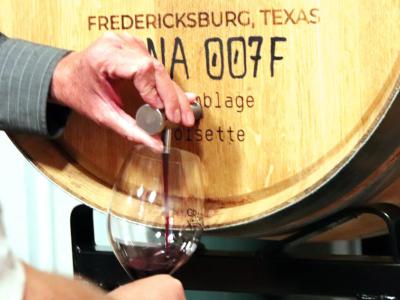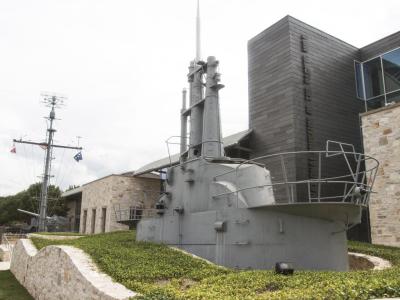Fredericksburg Introduction Walking Tour (Self Guided), Fredericksburg
A piece of Germany in the heart of Texas. The history of Fredericksburg dates back to its founding in 1846 by Baron Otfried Hans von Meusebach, who named it after Prince Frederick of Prussia.
Old-time German residents often referred to the place as Fritztown, a nickname still used in some businesses. Fredericksburg is also notable as the home of Texas German, a dialect spoken by the first generations of German settlers who initially refused to learn English.
During the Civil War, Fredericksburg was divided in its loyalties, reflecting the broader tensions of the era. While some residents aligned with the pro-Union Texas resistance, others remained loyal to the Confederacy.
In the 20th century, Fredericksburg remained a bastion of German heritage, largely isolated from outside influences. However, the town's trajectory shifted with the rise of Lyndon Johnson, whose presidency brought unprecedented attention to the area. A pivotal moment occurred in 1961 when Johnson, along with Fleet Admiral Chester Nimitz and German Chancellor Konrad Adenauer, visited Fredericksburg, drawing thousands of spectators and marking the town's emergence onto the national stage.
Subsequent events, including Johnson's presidency and the global musical fame of nearby Luckenbach, propelled Fredericksburg into a tourist destination, transforming its economy and cultural landscape. Today, the town – despite challenges associated with preserving its authentic rural identity and adapting to the demands of tourism and modernization – continues to attract visitors with its blend of German heritage, military history, and laid-back appeal.
For those eager to delve deeper into its past, the Pioneer Memorial Library and Pioneer Museum provide a fascinating glimpse into the days gone by. History buffs will also find no shortage of intrigue at the Admiral Nimitz Gallery and the National Museum of the Pacific War.
Meanwhile, the striking facades of Saint Mary's Catholic Church and the Holy Ghost German Lutheran Church stand as testaments to Fredericksburg's religious heritage.
A stroll down Main Street reveals a lovely mix of boutique shops, art galleries, and local eateries, inviting visitors to wander and explore at their leisure. Wine enthusiasts can indulge their senses at Grape Creek Vineyards on Main, where award-winning wines are crafted amid stunning vistas.
For a truly unique experience of two very different cultures in one place, one must visit Fredericksburg – a great mixture of Texan and German Heritage well worth learning about. So, come and explore the rolling hills of the Texas Hill Country, feel the southern charm, and enjoy the spirit of Fredericksburg for yourself!
Old-time German residents often referred to the place as Fritztown, a nickname still used in some businesses. Fredericksburg is also notable as the home of Texas German, a dialect spoken by the first generations of German settlers who initially refused to learn English.
During the Civil War, Fredericksburg was divided in its loyalties, reflecting the broader tensions of the era. While some residents aligned with the pro-Union Texas resistance, others remained loyal to the Confederacy.
In the 20th century, Fredericksburg remained a bastion of German heritage, largely isolated from outside influences. However, the town's trajectory shifted with the rise of Lyndon Johnson, whose presidency brought unprecedented attention to the area. A pivotal moment occurred in 1961 when Johnson, along with Fleet Admiral Chester Nimitz and German Chancellor Konrad Adenauer, visited Fredericksburg, drawing thousands of spectators and marking the town's emergence onto the national stage.
Subsequent events, including Johnson's presidency and the global musical fame of nearby Luckenbach, propelled Fredericksburg into a tourist destination, transforming its economy and cultural landscape. Today, the town – despite challenges associated with preserving its authentic rural identity and adapting to the demands of tourism and modernization – continues to attract visitors with its blend of German heritage, military history, and laid-back appeal.
For those eager to delve deeper into its past, the Pioneer Memorial Library and Pioneer Museum provide a fascinating glimpse into the days gone by. History buffs will also find no shortage of intrigue at the Admiral Nimitz Gallery and the National Museum of the Pacific War.
Meanwhile, the striking facades of Saint Mary's Catholic Church and the Holy Ghost German Lutheran Church stand as testaments to Fredericksburg's religious heritage.
A stroll down Main Street reveals a lovely mix of boutique shops, art galleries, and local eateries, inviting visitors to wander and explore at their leisure. Wine enthusiasts can indulge their senses at Grape Creek Vineyards on Main, where award-winning wines are crafted amid stunning vistas.
For a truly unique experience of two very different cultures in one place, one must visit Fredericksburg – a great mixture of Texan and German Heritage well worth learning about. So, come and explore the rolling hills of the Texas Hill Country, feel the southern charm, and enjoy the spirit of Fredericksburg for yourself!
How it works: Download the app "GPSmyCity: Walks in 1K+ Cities" from Apple App Store or Google Play Store to your mobile phone or tablet. The app turns your mobile device into a personal tour guide and its built-in GPS navigation functions guide you from one tour stop to next. The app works offline, so no data plan is needed when traveling abroad.
Fredericksburg Introduction Walking Tour Map
Guide Name: Fredericksburg Introduction Walking Tour
Guide Location: USA » Fredericksburg (See other walking tours in Fredericksburg)
Guide Type: Self-guided Walking Tour (Sightseeing)
# of Attractions: 11
Tour Duration: 2 Hour(s)
Travel Distance: 3.0 Km or 1.9 Miles
Author: DanaOffice
Sight(s) Featured in This Guide:
Guide Location: USA » Fredericksburg (See other walking tours in Fredericksburg)
Guide Type: Self-guided Walking Tour (Sightseeing)
# of Attractions: 11
Tour Duration: 2 Hour(s)
Travel Distance: 3.0 Km or 1.9 Miles
Author: DanaOffice
Sight(s) Featured in This Guide:
- Marktplatz von Fredericksburg (Marketplace of Fredericksburg)
- Vereins Kirche (Church Club Museum)
- Pioneer Memorial Library
- Pioneer Museum
- St. Mary's Catholic Church
- Holy Ghost German Lutheran Church
- Main Street
- Grape Creek Vineyards on Main
- Admiral Nimitz Gallery
- Japanese Garden of Peace
- National Museum of the Pacific War
1) Marktplatz von Fredericksburg (Marketplace of Fredericksburg)
Marketplace of Fredericksburg serves as a vibrant focal point that divides the Historic Main Street Shopping District and the West Main Shopping District. At the center of this charming park stands the Vereins Church, an octagonally shaped building that once housed the first church and school in Fredericksburg. Although the original structure was destroyed, a faithful replica now stands in its place, surrounded by lovely gardens and grounds that provide a picturesque backdrop for various events and activities.
Throughout the year, Marketplace hosts a plethora of festivals, concerts, and events that showcase the cultural vibrancy of Fredericksburg. During the mid-winter holiday season, visitors can enjoy the Icebahn outdoor skating rink, while warmer months bring the Farmers Market to the park, offering fresh local produce and artisanal goods. Families with children can delight in the canopied playground, which provides a safe and enjoyable space for youngsters to play, while the story-telling Maypole, offers insight into the history of Fredericksburg through its decorative branches.
Marketplace is adorned with numerous pavilions, picnic areas, and gathering spaces, making it an ideal spot for private parties and events. Visitors can meander along brick walkways, admire historical bronze sculptures depicting significant figures and events from Fredericksburg's past, and even witness the gentle motion of a working waterwheel. With amenities such as public restrooms, benches, and lush green spaces, Marketplace offers a tranquil retreat where locals and visitors alike can unwind, socialize, and immerse themselves in the beauty and history of Fredericksburg.
Throughout the year, Marketplace hosts a plethora of festivals, concerts, and events that showcase the cultural vibrancy of Fredericksburg. During the mid-winter holiday season, visitors can enjoy the Icebahn outdoor skating rink, while warmer months bring the Farmers Market to the park, offering fresh local produce and artisanal goods. Families with children can delight in the canopied playground, which provides a safe and enjoyable space for youngsters to play, while the story-telling Maypole, offers insight into the history of Fredericksburg through its decorative branches.
Marketplace is adorned with numerous pavilions, picnic areas, and gathering spaces, making it an ideal spot for private parties and events. Visitors can meander along brick walkways, admire historical bronze sculptures depicting significant figures and events from Fredericksburg's past, and even witness the gentle motion of a working waterwheel. With amenities such as public restrooms, benches, and lush green spaces, Marketplace offers a tranquil retreat where locals and visitors alike can unwind, socialize, and immerse themselves in the beauty and history of Fredericksburg.
2) Vereins Kirche (Church Club Museum)
The Church Club Museum offers visitors a glimpse into the rich history of the two Church Club buildings that have played significant roles in the community. The story of the Church Club begins with the arrival of the first German settlers in Texas and extends to present-day Fredericksburg, providing a fascinating perspective on the town's development and heritage.
The original Church Club served as a multi-purpose building, serving as a church, school, and community meeting place for five decades from 1847 to 1897. Located in the heart of Main Street, it held a central position in the life of the early settlers. Sadly, the original building was demolished in 1897, marking the end of an era. However, a replica Church Club was constructed in 1935 through a collaborative effort between the Gillespie County Historical Society and the Works Progress Administration (WPA), a New Deal agency initiated under President Franklin D. Roosevelt's administration.
Today, visitors to the Church Club Museum can explore exhibits that chronicle the history and significance of both iterations of the Church Club. Through artifacts, photographs, and interpretive displays, visitors gain insight into the daily lives of the early settlers, the cultural heritage of the German community, and the enduring legacy of the Church Club in shaping the identity of Fredericksburg.
The original Church Club served as a multi-purpose building, serving as a church, school, and community meeting place for five decades from 1847 to 1897. Located in the heart of Main Street, it held a central position in the life of the early settlers. Sadly, the original building was demolished in 1897, marking the end of an era. However, a replica Church Club was constructed in 1935 through a collaborative effort between the Gillespie County Historical Society and the Works Progress Administration (WPA), a New Deal agency initiated under President Franklin D. Roosevelt's administration.
Today, visitors to the Church Club Museum can explore exhibits that chronicle the history and significance of both iterations of the Church Club. Through artifacts, photographs, and interpretive displays, visitors gain insight into the daily lives of the early settlers, the cultural heritage of the German community, and the enduring legacy of the Church Club in shaping the identity of Fredericksburg.
3) Pioneer Memorial Library
The Pioneer Memorial Library stands as a testament to both architectural beauty and historical significance. Designed by renowned architect Alfred Giles, this stunning building began its life as the second courthouse for Gillespie County. Constructed in 1881-1882 using locally quarried stone, it served as the courthouse until 1939. Its distinctive design and picturesque setting make it one of the most beautiful structures in Fredericksburg.
Renovated in 1966-77 with generous support from Mr. and Mrs. Eugene McDermott, the building was rededicated as the Pioneer Memorial Library in 1967. Today, the library continues to be a hub of knowledge and community engagement, offering a wealth of resources both in print and online. Visitors to the library can explore its vast collection, which includes books, newspapers, magazines, and digital materials.
The library's interior is as impressive as its exterior, with the first floor housing the Children's Section and the second floor accommodating the Adult Section, Texas Room, and additional reading areas. The Pioneer Memorial Library is not only a cherished community institution but also holds historical significance, being listed on the National Register of Historic Places since 1971 and designated as a Recorded Texas Historic Landmark in 1967.
Renovated in 1966-77 with generous support from Mr. and Mrs. Eugene McDermott, the building was rededicated as the Pioneer Memorial Library in 1967. Today, the library continues to be a hub of knowledge and community engagement, offering a wealth of resources both in print and online. Visitors to the library can explore its vast collection, which includes books, newspapers, magazines, and digital materials.
The library's interior is as impressive as its exterior, with the first floor housing the Children's Section and the second floor accommodating the Adult Section, Texas Room, and additional reading areas. The Pioneer Memorial Library is not only a cherished community institution but also holds historical significance, being listed on the National Register of Historic Places since 1971 and designated as a Recorded Texas Historic Landmark in 1967.
4) Pioneer Museum (must see)
The Pioneer Museum offers visitors a captivating journey through the rich history of the region's early pioneers. Situated in downtown Fredericksburg on a sprawling 3.5-acre complex, this museum showcases authentic buildings, artifacts, and displays that bring to life the experiences of the area's earliest settlers. Among the highlights are a one-room schoolhouse, log cabin, Sunday house, barn, and smokehouse, providing visitors with a hands-on glimpse into the daily lives of those who shaped the region's German heritage over 175 years ago.
Throughout the year, the Pioneer Museum hosts engaging events staffed by docents in period attire, offering fun and educational experiences for the whole family. These events often include activities such as storytelling, rope making, soap making, and sheep shearing, providing visitors with interactive opportunities to learn about traditional pioneer skills and customs. Whether it's listening to tales of the past or trying their hand at historical crafts, visitors can immerse themselves in the vibrant history of Gillespie County.
Recognized for its commitment to preserving and sharing local history, the Pioneer Museum is nationally accredited by the American Alliance of Museums. In addition to its regular exhibits and events, the museum also offers special tours of other historic homes and sites owned by the Gillespie County Historical Society, providing visitors with deeper insights into the area's fascinating heritage.
Throughout the year, the Pioneer Museum hosts engaging events staffed by docents in period attire, offering fun and educational experiences for the whole family. These events often include activities such as storytelling, rope making, soap making, and sheep shearing, providing visitors with interactive opportunities to learn about traditional pioneer skills and customs. Whether it's listening to tales of the past or trying their hand at historical crafts, visitors can immerse themselves in the vibrant history of Gillespie County.
Recognized for its commitment to preserving and sharing local history, the Pioneer Museum is nationally accredited by the American Alliance of Museums. In addition to its regular exhibits and events, the museum also offers special tours of other historic homes and sites owned by the Gillespie County Historical Society, providing visitors with deeper insights into the area's fascinating heritage.
5) St. Mary's Catholic Church (must see)
Saint Mary's Catholic Church traces its roots back to the mid-19th century when the first Catholic church in Fredericksburg was a humble log house constructed in 1848. This early structure was replaced in 1861 by a more substantial stone building, now known as Old Saint Mary's, which has since served various purposes, including as a schoolhouse. Its historical significance in the context of German immigration to Texas earned it recognition as a Recorded Texas Historic Landmark in 1994.
As the congregation grew over the years, the need for a larger church became evident. In response, a new church was designed by San Antonio architect Leo M.J. Dielmann and constructed in 1906 by contractor Jacob Wagner. The current Saint Mary's Church features striking Gothic elements such as buttresses, trefoil motifs, and a prominent corner tower that rises above the roofline, adding to its architectural grandeur. Inside, visitors are treated to an impressive array of paintings and murals, including adornments on the organ pipes and ceiling vaults, contributing to its designation as a painted church and its inclusion in the National Register of Historic Places.
The significance of Saint Mary's extends beyond its architectural and historical importance. The church campus also includes Our Lady of Guadalupe Catholic Church, located at 302 East College Street. Originally opened in 1919, Our Lady of Guadalupe Church was later closed and reopened as a mission of Saint Mary's in 1983, serving the Spanish-speaking community.
As the congregation grew over the years, the need for a larger church became evident. In response, a new church was designed by San Antonio architect Leo M.J. Dielmann and constructed in 1906 by contractor Jacob Wagner. The current Saint Mary's Church features striking Gothic elements such as buttresses, trefoil motifs, and a prominent corner tower that rises above the roofline, adding to its architectural grandeur. Inside, visitors are treated to an impressive array of paintings and murals, including adornments on the organ pipes and ceiling vaults, contributing to its designation as a painted church and its inclusion in the National Register of Historic Places.
The significance of Saint Mary's extends beyond its architectural and historical importance. The church campus also includes Our Lady of Guadalupe Catholic Church, located at 302 East College Street. Originally opened in 1919, Our Lady of Guadalupe Church was later closed and reopened as a mission of Saint Mary's in 1983, serving the Spanish-speaking community.
6) Holy Ghost German Lutheran Church
Holy Ghost Lutheran Church stands as a testament to over 130 years of spiritual guidance and community service in the Hill Country region. Established as the oldest congregation in the city, Holy Ghost Lutheran Church has played a pivotal role in the growth and development of Fredericksburg, originally founded by German immigrants and now renowned as a prominent destination in Texas tourism.
The congregation's history dates back to 1846 when the Rev. Henry Basse conducted the first Protestant services in Fredericksburg. Initially, worship services were held at the old Vereins Kirche until 1888, when Carl Priess generously donated the land for the construction of a new church building. The cornerstone of the current structure was laid in 1893, and the church gradually expanded over the years, with the addition of a bell tower that houses an original bell from the Vereins Kirche. In 1948-49, significant renovations and enlargements were undertaken, culminating in the church being officially named Holy Ghost Lutheran Church.
Today, Holy Ghost Lutheran Church continues to serve as a spiritual anchor for the community. The church's enduring presence and iconic bell tower symbolize its commitment to faith, heritage, and community, embodying the rich history and cultural heritage of Fredericksburg.
The congregation's history dates back to 1846 when the Rev. Henry Basse conducted the first Protestant services in Fredericksburg. Initially, worship services were held at the old Vereins Kirche until 1888, when Carl Priess generously donated the land for the construction of a new church building. The cornerstone of the current structure was laid in 1893, and the church gradually expanded over the years, with the addition of a bell tower that houses an original bell from the Vereins Kirche. In 1948-49, significant renovations and enlargements were undertaken, culminating in the church being officially named Holy Ghost Lutheran Church.
Today, Holy Ghost Lutheran Church continues to serve as a spiritual anchor for the community. The church's enduring presence and iconic bell tower symbolize its commitment to faith, heritage, and community, embodying the rich history and cultural heritage of Fredericksburg.
7) Main Street (must see)
Main Street in Fredericksburg, Texas, serves as the vibrant heart of the city's shopping and cultural scene, earning the moniker "The Magic Mile" for its array of top-quality shops and historic charm. This central shopping district is characterized by its picturesque streets lined with well-preserved historical buildings, creating a delightful ambiance for leisurely strolls and shopping excursions. Separated from the West Main Street shopping district by Marketplace, Main Street begins east of the Admiral Nimitz Museum and extends westward to the lively Marketplace square.
Along Main Street, visitors can explore a diverse selection of boutiques, galleries, antique shops, and specialty stores housed within elegant historical structures. The wide sidewalks and inviting courtyards enhance the pedestrian-friendly atmosphere, inviting shoppers to browse at their leisure while soaking in the small-town charm of Fredericksburg. Marketplace square, located in the 100 block of Main Street, serves as a focal point for community gatherings and events, offering pavilions, picnic areas, and lush native gardens adorned with heirloom roses.
Whether indulging in shopping, exploring cultural attractions, or simply enjoying the serene ambiance, Main Street in Fredericksburg offers an unforgettable experience that captures the essence of Texas Hill Country hospitality and heritage.
Along Main Street, visitors can explore a diverse selection of boutiques, galleries, antique shops, and specialty stores housed within elegant historical structures. The wide sidewalks and inviting courtyards enhance the pedestrian-friendly atmosphere, inviting shoppers to browse at their leisure while soaking in the small-town charm of Fredericksburg. Marketplace square, located in the 100 block of Main Street, serves as a focal point for community gatherings and events, offering pavilions, picnic areas, and lush native gardens adorned with heirloom roses.
Whether indulging in shopping, exploring cultural attractions, or simply enjoying the serene ambiance, Main Street in Fredericksburg offers an unforgettable experience that captures the essence of Texas Hill Country hospitality and heritage.
8) Grape Creek Vineyards on Main (must see)
Grape Creek Vineyards on Main offers wine enthusiasts a sophisticated and inviting tasting experience in the heart of downtown Fredericksburg. The tasting room exudes elegance and charm, providing visitors with the perfect setting to sample award-winning wines crafted by Grape Creek Vineyards. The winery produces an impressive 60,000 cases per year, employing a blend of modern and traditional techniques to allow each wine to develop its unique character and flavor profile.
Wine connoisseurs and novices alike can indulge in a flight of Grape Creek's current releases, savoring the distinctive notes and aromas of their premium wines. Whether you prefer French or Italian varietals, Grape Creek offers a diverse selection that caters to a range of palates. Visitors can also purchase bottles to take home, allowing them to enjoy the Grape Creek experience long after their visit to Fredericksburg.
In addition to its exceptional wines, Grape Creek Vineyards on Main provides guests with a glimpse into the winemaking process and the opportunity to learn about the Heath Family Brand collections, which have received over 150 prestigious 90+ scores. While the urban tasting room offers a convenient location for sampling Grape Creek's offerings, the true magic happens at their winery and vineyard estate, just a short drive away. Guests are encouraged to embark on a scenic drive through the picturesque Hill Country to witness firsthand where the winemaking process begins and to explore the vineyard's idyllic surroundings.
Wine connoisseurs and novices alike can indulge in a flight of Grape Creek's current releases, savoring the distinctive notes and aromas of their premium wines. Whether you prefer French or Italian varietals, Grape Creek offers a diverse selection that caters to a range of palates. Visitors can also purchase bottles to take home, allowing them to enjoy the Grape Creek experience long after their visit to Fredericksburg.
In addition to its exceptional wines, Grape Creek Vineyards on Main provides guests with a glimpse into the winemaking process and the opportunity to learn about the Heath Family Brand collections, which have received over 150 prestigious 90+ scores. While the urban tasting room offers a convenient location for sampling Grape Creek's offerings, the true magic happens at their winery and vineyard estate, just a short drive away. Guests are encouraged to embark on a scenic drive through the picturesque Hill Country to witness firsthand where the winemaking process begins and to explore the vineyard's idyllic surroundings.
9) Admiral Nimitz Gallery
The Admiral Nimitz Gallery serves as a poignant tribute to the heroes of World War II's Pacific fleet. Through immersive and interactive learning experiences, video presentations, and personal heirlooms, the gallery offers visitors a compelling insight into the challenges and triumphs faced by those who served during this pivotal period in history.
Central to the gallery's narrative is Fleet Admiral Chester W. Nimitz, a revered figure and native son of Fredericksburg whose leadership played a pivotal role in shaping the outcome of the war in the Pacific. Through a comprehensive exploration of Nimitz's life and career, visitors gain a profound understanding of his strategic genius, unwavering resolve, and profound impact on the course of history. The gallery's recent $4.5 million renovation, completed in February 2020, represents a significant milestone in its ongoing mission to honor Admiral Nimitz's legacy and preserve the memory of those who served under his command.
The renovation not only expanded the gallery's physical footprint by fifty percent but also introduced state-of-the-art interactive features and multimedia enhancements, allowing visitors to engage with the exhibits in new and immersive ways. With a doubled collection of Nimitz artifacts now on display, including personal mementos, wartime memorabilia, and rare historical documents, the gallery offers a more comprehensive and nuanced portrayal of Admiral Nimitz's remarkable life and achievements.
Central to the gallery's narrative is Fleet Admiral Chester W. Nimitz, a revered figure and native son of Fredericksburg whose leadership played a pivotal role in shaping the outcome of the war in the Pacific. Through a comprehensive exploration of Nimitz's life and career, visitors gain a profound understanding of his strategic genius, unwavering resolve, and profound impact on the course of history. The gallery's recent $4.5 million renovation, completed in February 2020, represents a significant milestone in its ongoing mission to honor Admiral Nimitz's legacy and preserve the memory of those who served under his command.
The renovation not only expanded the gallery's physical footprint by fifty percent but also introduced state-of-the-art interactive features and multimedia enhancements, allowing visitors to engage with the exhibits in new and immersive ways. With a doubled collection of Nimitz artifacts now on display, including personal mementos, wartime memorabilia, and rare historical documents, the gallery offers a more comprehensive and nuanced portrayal of Admiral Nimitz's remarkable life and achievements.
10) Japanese Garden of Peace
Established over 40 years ago, the Japanese Garden of Peace serves as a living memorial, meticulously crafted to embody the spirit of harmony and goodwill. A cherished gift from the people of Japan, the garden's design reflects the profound values of loyalty, unity, and tranquility.
At the heart of the Japanese Garden of Peace lies the Ishin-no-Ike, or "pond of one heart," a serene water feature surrounded by carefully arranged trees and lush foliage. Symbolizing loyalty and unity, this central element serves as a focal point for contemplation and reflection. The tranquil sounds of water trickling and leaves rustling in the gentle breeze create an atmosphere of serenity and peace, inviting visitors to immerse themselves in the beauty of nature.
Throughout the garden, visitors will encounter meticulously manicured landscapes and symbolic elements that pay homage to Japanese culture and tradition. Raked gravel pathways evoke the rhythmic motion of ocean waves, while carefully placed stones and plantings represent the scattered islands of the Pacific. A meditation structure, reminiscent of a traditional Japanese house from the Taisho Era, offers a sanctuary for quiet contemplation. Constructed without nails and adorned with shoji screens, this architectural marvel transports visitors to a bygone era of simplicity and elegance.
One of the most poignant features of the Japanese Garden of Peace is the pool shaped into Japanese characters that signify "one heart." This symbolic gesture serves as a powerful reminder of the profound connections that unite people across cultures and continents. As visitors wander through this tranquil oasis, they are invited to reflect on the shared values of peace, friendship, and mutual respect that define the enduring bond between Japan and the United States.
At the heart of the Japanese Garden of Peace lies the Ishin-no-Ike, or "pond of one heart," a serene water feature surrounded by carefully arranged trees and lush foliage. Symbolizing loyalty and unity, this central element serves as a focal point for contemplation and reflection. The tranquil sounds of water trickling and leaves rustling in the gentle breeze create an atmosphere of serenity and peace, inviting visitors to immerse themselves in the beauty of nature.
Throughout the garden, visitors will encounter meticulously manicured landscapes and symbolic elements that pay homage to Japanese culture and tradition. Raked gravel pathways evoke the rhythmic motion of ocean waves, while carefully placed stones and plantings represent the scattered islands of the Pacific. A meditation structure, reminiscent of a traditional Japanese house from the Taisho Era, offers a sanctuary for quiet contemplation. Constructed without nails and adorned with shoji screens, this architectural marvel transports visitors to a bygone era of simplicity and elegance.
One of the most poignant features of the Japanese Garden of Peace is the pool shaped into Japanese characters that signify "one heart." This symbolic gesture serves as a powerful reminder of the profound connections that unite people across cultures and continents. As visitors wander through this tranquil oasis, they are invited to reflect on the shared values of peace, friendship, and mutual respect that define the enduring bond between Japan and the United States.
11) National Museum of the Pacific War (must see)
The National Museum of the Pacific War stands as a poignant tribute to the bravery and sacrifices of those who served in the Pacific War during World War II. Recognized as the fifth-best history museum in the United States by USA Today readers in 2020, the museum offers visitors a comprehensive and immersive experience. One of the museum's highlights is the Admiral Nimitz Gallery, which explores the life and legacy of Fleet Admiral Chester W. Nimitz, a native of Fredericksburg and a key figure in the Pacific War.
The George Bush Gallery of the Pacific War offers a comprehensive overview of the events, battles, and key figures of the Pacific Theater. Through engaging displays and multimedia presentations, visitors can delve into the complexities of this theater of war and gain a deeper understanding of its impact on global history. Additionally, the Plaza of the Presidents, Japanese Garden of Peace, Memorial Walk, and Pacific Combat Zone are integral components of the museum complex, offering visitors opportunities for reflection, commemoration, and education.
As visitors explore the National Museum of the Pacific War, they are immersed in the sights, sounds, and stories of one of the most pivotal chapters in world history.
The George Bush Gallery of the Pacific War offers a comprehensive overview of the events, battles, and key figures of the Pacific Theater. Through engaging displays and multimedia presentations, visitors can delve into the complexities of this theater of war and gain a deeper understanding of its impact on global history. Additionally, the Plaza of the Presidents, Japanese Garden of Peace, Memorial Walk, and Pacific Combat Zone are integral components of the museum complex, offering visitors opportunities for reflection, commemoration, and education.
As visitors explore the National Museum of the Pacific War, they are immersed in the sights, sounds, and stories of one of the most pivotal chapters in world history.
The Most Popular Cities
/ view all
